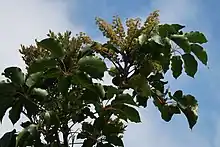| Sciodaphyllum pittieri | |
|---|---|
 | |
| Scientific classification | |
| Kingdom: | Plantae |
| Clade: | Tracheophytes |
| Clade: | Angiosperms |
| Clade: | Eudicots |
| Clade: | Asterids |
| Order: | Apiales |
| Family: | Araliaceae |
| Subfamily: | Aralioideae |
| Genus: | Sciodaphyllum |
| Species: | S. pittieri |
| Binomial name | |
| Sciodaphyllum pittieri | |
| Synonyms[2] | |
| |
Sciodaphyllum pittieri is a species of flowering plant in genus Sciodaphyllum. It is native to the mountain forests of Costa Rica and western Panama.[1]
Description
Sciodaphyllum pittieri is an evergreen tree, which grows up to 25 meters high, thickly branched, with a trunk up to 40 cm in diameter. The bark is thin, flat, and mottled.[3]
Its leaves are oblong, up to 45 cm long and 19 cm wide, with a pointed tip. They are glossy on the upper side, and densely rusty-hairy underneath. They grow clustered in spirals at the end of stalks up to 1 m long.[3]
The trees bloom from February to September. The inflorescences are dense drooping cylindrical clusters up to 50 cm long, composed of numerous minute white to pale green flowers. Fleshy fruits form from May to September. They are 1 cm long by 4mm wide, white turning red or purple, and each contains two seeds.[3]
Range and habitat
Sciodaphyllum pittieri is native to the mountains of Costa Rica and western Panama, including the Cordillera Central and Cordillera de Talamanca.[1]
It is found in humid montane forests from 800 to 3,200 meters elevation, where it is frequently found in clearings and secondary growth.[3] It is a common canopy tree in upper montane forests dominated by the oak Quercus costaricensis.[4]
References
- 1 2 3 Botanic Gardens Conservation International (BGCI) & IUCN SSC Global Tree Specialist Group. 2018. Schefflera rodriguesiana. The IUCN Red List of Threatened Species 2018: e.T136094018A136094020. https://dx.doi.org/10.2305/IUCN.UK.2018-2.RLTS.T136094018A136094020.en. Accessed 31 January 2023.
- ↑ Sciodaphyllum pittieri (Marchal ex T.Durand & Pittier) Lowry, G.M.Plunkett & M.M.Mora. Plants of the World Online, Kew Science. Accessed 30 January 2023.
- 1 2 3 4 Magnuson, B., Gargiullo, M. (2008). A Field Guide to Plants of Costa Rica. United Kingdom: Oxford University Press, USA.
- ↑ Kappelle, M., van Uffelen, J.G. (2006). Altitudinal Zonation of Montane Oak Forests Along Climate and Soil Gradients in Costa Rica. In: Kappelle, M. (eds) Ecology and Conservation of Neotropical Montane Oak Forests. Ecological Studies, vol 185. Springer, Berlin, Heidelberg. https://doi.org/10.1007/3-540-28909-7_4
